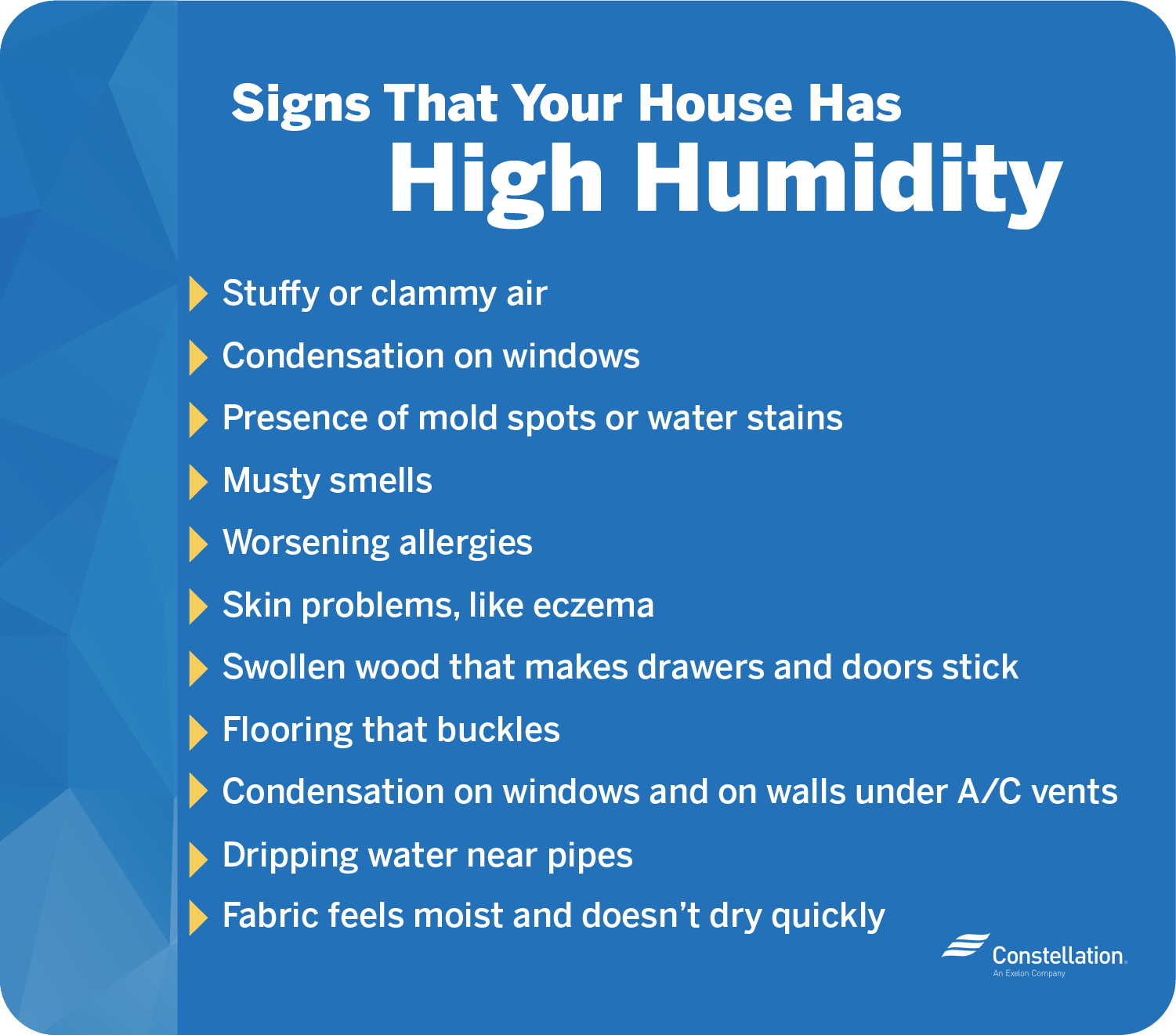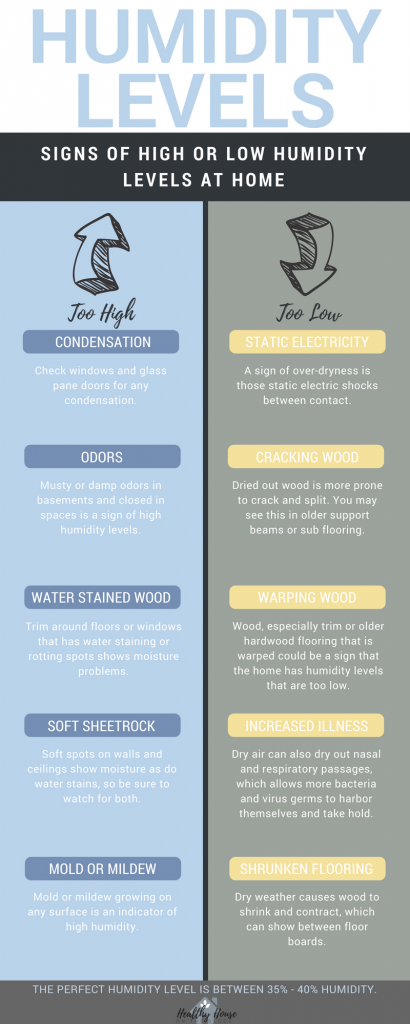Table Of Content

Relative humidity refers to the amount of water in the air compared to the amount the air can hold at a given temperature. If the relative humidity is 50%, the air is only holding about half the amount of moisture it’s capable of holding at that temperature. Dirty filters in heating and cooling systemscan impede the free flow of air through your home. Make sure to check, clean,or replace them regularly to optimize ventilation. When doing laundry, makesure to clean the lint trap each cycle and ensure the exhaust vent functionsproperly. High levels of humidity cancreate a dangerous breeding ground for bacteria, fungi (fungus), mould and dustmites.
The climate affects the humidity level in your home.
Whole-house dehumidifiers typically require dedicated 120 or 240-volt electrical circuits and a drain line to the home’s exterior. Pricing can vary by model and installing contractor, but homeowners typically expect to spend between $1,100 and $2,900 for the product, installation materials, and labor. Adequate ventilation can help control a home’s humidity level, impacting health and a home’s structural integrity.
How Can You Measure Your Home’s Humidity Levels?
Summer heat can cause high humidity levels in your home, but reduced ventilation, leaks, poor insulation, and everyday activities—such as cooking and showering—can also generate excess moisture. To lower your home’s humidity level, you need to reduce the amount of moisture in the air. A whole-house dehumidifier is likely the best way to accomplish this task if you regularly battle high indoor humidity. You’ll also want to change the filter in your heating and air conditioner system as recommended (usually every days) and have the unit inspected each year for needed maintenance. Beyond installing an effective humidifier, you might want to invest in an Energy Recovery Ventilator.
Relative Humidity Chart
However, exceeding 60% can lead to issues such as mold growth and respiratory problems. As most people are aware, high levels of dampness and humidity can supply enough moisture to facilitate mold growth. Asthma is an incredibly common condition that makes it difficult to breathe. The Harvard Review found that 21%3 of the 21.8 million cases of asthma annually are attributable to residential dampness and mold.
What Is the Ideal Humidity Level for Your House?
Commonly controlled by an indoor humidistat, whole-house humidifiers will add moisture to the air until it reaches the relative humidity percentage of your choosing. Whole-house humidifier installation costs vary based on several factors, but the national average is around $2,250. Typically, homeowners can expect to spend between $900 and $3,600 on a professional whole-house humidifier installation.
Having old insulation replaced, especially in the attic and basement, could be the key to eliminating excess moisture in the air. If it isn’t possible to completely replace the home’s insulation, caulking or sealing windows throughout the home can be another effective way to restore the home to a more ideal inside humidity level. Keeping areas ventilated by opening a window or installing an exhaust fan can lower humidity inside the house. A professional can direct certain appliances, such as clothes dryers and stoves, to vent outside of the home. A whole-house dehumidifier costs $1,500 on average and can also help eliminate some of the moisture created by these activities.
Environmental Protection Agency (EPA), the ideal indoor relative humidity is between 30% and 50% — and must be kept below 60%. Low indoor humidity means that your house’s humidity level is below 30%. Colder weather in the winter months can lead to a drop in humidity levels. When it enters your home, your heating system warms it up and removes even more moisture.
Use indoor humidity gauges to determine how much moisture is in the air.
Insufficient humidity can also make you feel colder, tempting you to turn the thermostat higher than necessary — and leading to a higher heating bill. If you have a problem with humidity in your home, it is best to resolve the issue rather than relying on fans. A fan can play an important role and help mitigate some excess moisture effects, but ultimately you should consider a more permanent solution. All that’s required is minutes of fresh air from several open windows, so you get a ‘through-draft’, and you’re done.
Brownsville ranked as the most humid city in the U.S. - KVEO-TV
Brownsville ranked as the most humid city in the U.S..
Posted: Thu, 25 Aug 2022 07:00:00 GMT [source]
The signs of high humidity in the home include a musty smell, condensation on your windows, mold growth, and peeling paint. Humidity control in the house is important to maintaining Healthy Humidity. The effects of humidity can have a major impact on the way you feel. The American Society of Heating Refrigeration, Air Conditioning Engineers recommends keeping your home's relative humidity between percent. The easiest solution for controlling humidityin a house is to use a humidifier. You can buy small, portable units or have aprofessional install a central humidifier in your HVAC system.

Research shows that the ideal relative humidity for your home is between 40%-60%. However, to discourage the growth and spread of mold, levels should be kept below 50%. This relative humidity in your home should also scale with the outdoor absolute humidity. So now that we’ve talked about comfort levels, you can probably guess what we’ll say next.
When it comes to your home, overly humid air creates a breeding ground for mold and mildew, which results in costly damage. Over time, high humidity levels can cause wood to rot and attract unwanted insects. Too much humidity also causes swelling in furniture and other items, causing them to warp.
We have grilled the experts on the subject to discover not only what the optimal humidity levels in your house should be, but also how you can achieve them. The soil outdoors may not be the first thing that comes to mind when homeowners wonder “Why is it so humid in my house? ” However, humidity can come up through the soil underneath the foundation of the home. This is called rising damp, and ineffective grading can be a significant factor since groundwater and rain can accumulate in a home’s foundation.
There are several ways to check the humidity in a home, including a hygrometer, thermostat, humidistat, and the home humidifier or dehumidifier. Use the relative humidity chart below to maintain the ideal humidity in the house. For a quality portable humidifier or dehumidifier, you’ll pay between $30 and $250, depending on your needs. If, however, you prefer to have a whole-home humidifier system installed, your investment will run $576 on average.
This will remove a lot of the trapped moisture and allow you to let other nasties, such as Volatile Organic Compounds (or VOCs, for short), to escape as well. Remove branches or vegetation from around your roofor foundation. Frequently inspect your roof for loose shingles or flashingsthat could leak rain into attics, walls, insulation and other areas. Keepgutters and downspouts clean so that water can drain properly. Install awningsor sloped ledges above windows and doors to ensure all water runs away fromthem.

No comments:
Post a Comment